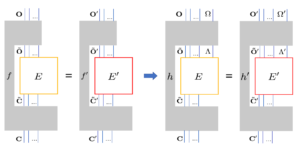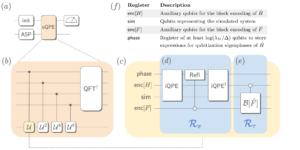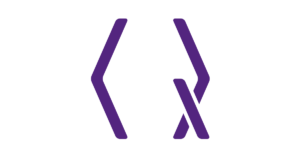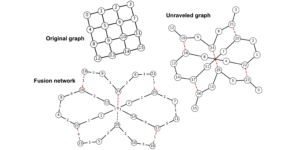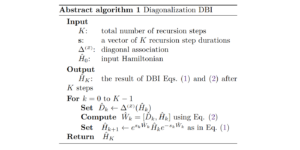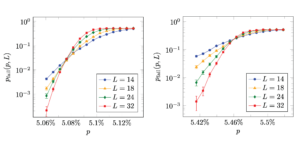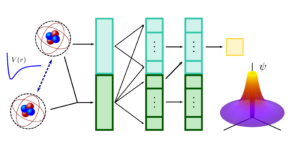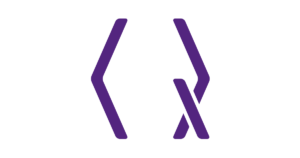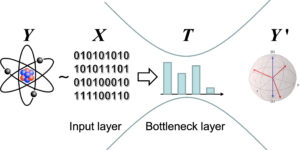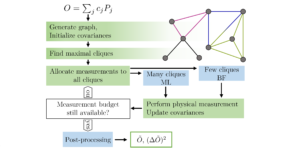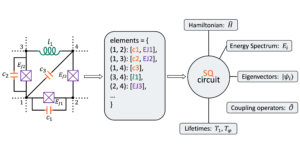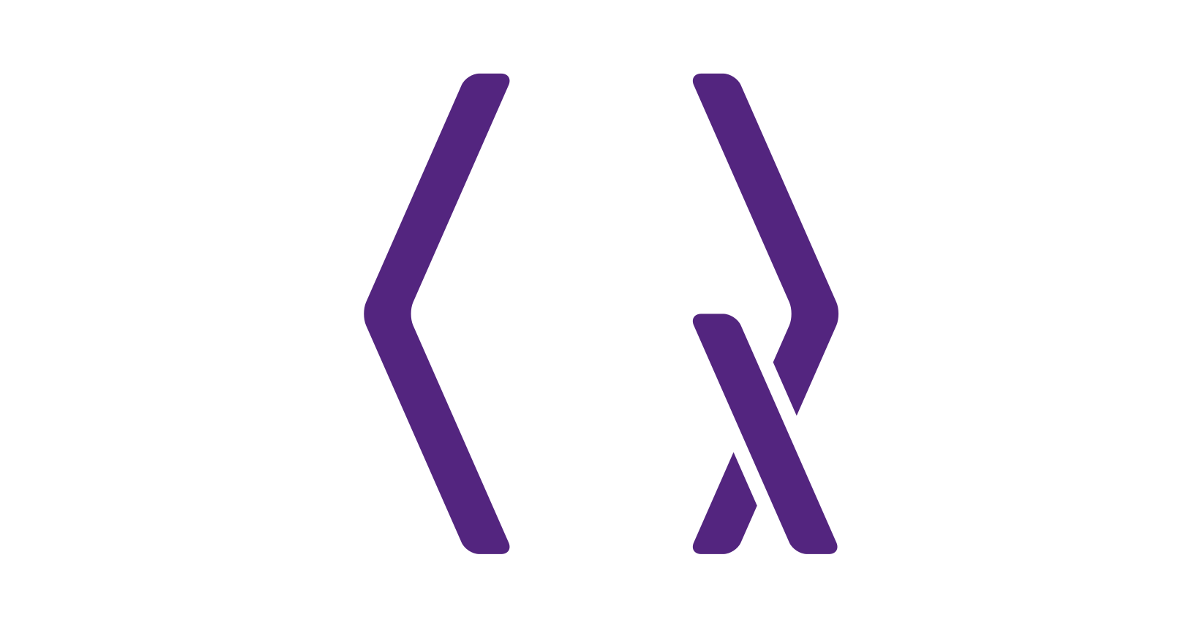
1Department of Materials, University of Oxford, Parks Road, Oxford OX1 3PH, United Kingdom
2Quantum Motion, 9 Sterling Way, London N7 9HJ, United Kingdom
Find this paper interesting or want to discuss? Scite or leave a comment on SciRate.
Abstract
Whether it is at the fabrication stage or during the course of the quantum computation, e.g. because of high-energy events like cosmic rays, the qubits constituting an error correcting code may be rendered inoperable. Such defects may correspond to individual qubits or to clusters and could potentially disrupt the code sufficiently to generate logical errors. In this paper, we explore a novel $adaptive$ approach for surface code quantum error correction on a defective lattice. We show that combining an appropriate defect detection algorithm and a quarantine of the identified zone allows one to preserve the advantage of quantum error correction at finite code sizes, at the cost of a qubit overhead that scales with the size of the defect. Our numerics indicate that the code’s threshold need not be significantly affected; for example, for a certain scenario where small defects repeatedly arise in each logical qubit, the noise threshold is $2.7%$ (versus the defect-free case of $2.9%$). These results pave the way to the experimental implementation of large-scale quantum computers where defects will be inevitable.
► BibTeX data
► References
[1] Austin G. Fowler, Matteo Mariantoni, John M. Martinis, and Andrew N. Cleland. Surface codes: Towards practical large-scale quantum computation. Physical Review A, 86 (3), sep 2012. 10.1103/physreva.86.032324.
https://doi.org/10.1103/physreva.86.032324
[2] Craig Gidney and Martin Ekerå. How to factor 2048 bit RSA integers in 8 hours using 20 million noisy qubits. Quantum, 5: 433, apr 2021. 10.22331/q-2021-04-15-433.
https://doi.org/10.22331/q-2021-04-15-433
[3] Exponential suppression of bit or phase errors with cyclic error correction. Nature, 595 (7867): 383–387, 2021. 10.1038/s41586-021-03588-y.
https://doi.org/10.1038/s41586-021-03588-y
[4] Peter W. Shor. Scheme for reducing decoherence in quantum computer memory. Phys. Rev. A, 52: R2493–R2496, Oct 1995. 10.1103/PhysRevA.52.R2493.
https://doi.org/10.1103/PhysRevA.52.R2493
[5] Barbara M. Terhal. Quantum error correction for quantum memories. Reviews of Modern Physics, 87 (2): 307–346, apr 2015. 10.1103/revmodphys.87.307.
https://doi.org/10.1103/revmodphys.87.307
[6] Earl T. Campbell, Barbara M. Terhal, and Christophe Vuillot. Roads towards fault-tolerant universal quantum computation. Nature, 549 (7671): 172–179, sep 2017. 10.1038/nature23460.
https://doi.org/10.1038/nature23460
[7] John M. Martinis. Saving superconducting quantum processors from qubit decay and correlated errors generated by gamma and cosmic rays. 2020. 10.1038/s41534-021-00431-0.
https://doi.org/10.1038/s41534-021-00431-0
[8] C. D. Wilen, S. Abdullah, N. A. Kurinsky, C. Stanford, L. Cardani, G. D’Imperio, C. Tomei, L. Faoro, L. B. Ioffe, C. H. Liu, A. Opremcak, B. G. Christensen, J. L. DuBois, and R. McDermott. Correlated charge noise and relaxation errors in superconducting qubits. Nature, 594 (7863): 369–373, jun 2021. 10.1038/s41586-021-03557-5.
https://doi.org/10.1038/s41586-021-03557-5
[9] Resolving catastrophic error bursts from cosmic rays in large arrays of superconducting qubits. Nature Physics, 18 (1): 107–111, dec 2021. 10.1038/s41567-021-01432-8.
https://doi.org/10.1038/s41567-021-01432-8
[10] J. Vala, K. B. Whaley, and D. S. Weiss. Quantum error correction of a qubit loss in an addressable atomic system. Phys. Rev. A, 72: 052318, Nov 2005. 10.1103/PhysRevA.72.052318.
https://doi.org/10.1103/PhysRevA.72.052318
[11] Alejandro Bermudez, Xiaosi Xu, Ramil Nigmatullin, Joe O’Gorman, Vlad Negnevitsky, Philipp Schindler, Thomas Monz, UG Poschinger, Cornelius Hempel, Jonathan Home, et al. Assessing the progress of trapped-ion processors towards fault-tolerant quantum computation. Physical Review X, 7 (4): 041061, 2017. 10.1103/physrevx.7.041061.
https://doi.org/10.1103/physrevx.7.041061
[12] Iris Cong, Harry Levine, Alexander Keesling, Dolev Bluvstein, Sheng-Tao Wang, and Mikhail D. Lukin. Hardware-efficient, fault-tolerant quantum computation with rydberg atoms. 2021. 10.48550/ARXIV.2105.13501.
https://doi.org/10.48550/ARXIV.2105.13501
[13] Natalie C Brown, Michael Newman, and Kenneth R Brown. Handling leakage with subsystem codes. New Journal of Physics, 21 (7): 073055, jul 2019. 10.1088/1367-2630/ab3372.
https://doi.org/10.1088/1367-2630/ab3372
[14] Benjamin J. Brown, Katharina Laubscher, Markus S. Kesselring, and James R. Wootton. Poking holes and cutting corners to achieve clifford gates with the surface code. Phys. Rev. X, 7: 021029, May 2017. 10.1103/PhysRevX.7.021029.
https://doi.org/10.1103/PhysRevX.7.021029
[15] Suppressing quantum errors by scaling a surface code logical qubit. Nature, 614 (7949): 676–681, 2023. https://doi.org/10.1038/s41586-022-05434-1.
https://doi.org/10.1038/s41586-022-05434-1
[16] Qian Xu, Alireza Seif, Haoxiong Yan, Nam Mannucci, Bernard Ousmane Sane, Rodney Van Meter, Andrew N. Cleland, and Liang Jiang. Distributed quantum error correction for chip-level catastrophic errors. 2022. 10.48550/ARXIV.2203.16488.
https://doi.org/10.48550/ARXIV.2203.16488
[17] Thomas M. Stace, Sean D. Barrett, and Andrew C. Doherty. Thresholds for topological codes in the presence of loss. Physical Review Letters, 102 (20), may 2009. 10.1103/physrevlett.102.200501.
https://doi.org/10.1103/physrevlett.102.200501
[18] Shota Nagayama, Austin G Fowler, Dominic Horsman, Simon J Devitt, and Rodney Van Meter. Surface code error correction on a defective lattice. New Journal of Physics, 19 (2): 023050, feb 2017. 10.1088/1367-2630/aa5918.
https://doi.org/10.1088/1367-2630/aa5918
[19] James M. Auger, Hussain Anwar, Mercedes Gimeno-Segovia, Thomas M. Stace, and Dan E. Browne. Fault-tolerance thresholds for the surface code with fabrication errors. Physical Review A, 96 (4), oct 2017. 10.1103/physreva.96.042316.
https://doi.org/10.1103/physreva.96.042316
[20] Armands Strikis, Simon C. Benjamin, and Benjamin J. Brown. Quantum computing is scalable on a planar array of qubits with fabrication defects. arXiv e-prints, art. arXiv:2111.06432, November 2021. 10.48550/arXiv.2111.06432.
https://doi.org/10.48550/arXiv.2111.06432
arXiv:2111.06432
[21] Adam Paetznick and Ben W. Reichardt. Universal fault-tolerant quantum computation with only transversal gates and error correction. Physical Review Letters, 111 (9), aug 2013. 10.1103/physrevlett.111.090505.
https://doi.org/10.1103/physrevlett.111.090505
[22] Oscar Higgott and Nikolas P. Breuckmann. Subsystem codes with high thresholds by gauge fixing and reduced qubit overhead. Physical Review X, 11 (3), aug 2021. 10.1103/physrevx.11.031039.
https://doi.org/10.1103/physrevx.11.031039
[23] Christophe Vuillot, Lingling Lao, Ben Criger, Carmen Garcí a Almudéver, Koen Bertels, and Barbara M Terhal. Code deformation and lattice surgery are gauge fixing. New Journal of Physics, 21 (3): 033028, mar 2019. 10.1088/1367-2630/ab0199.
https://doi.org/10.1088/1367-2630/ab0199
[24] Matt McEwen, Dave Bacon, and Craig Gidney. Relaxing hardware requirements for surface code circuits using time-dynamics. 2023. 10.48550/arXiv.2302.02192.
https://doi.org/10.48550/arXiv.2302.02192
[25] Joschka Roffe, David R. White, Simon Burton, and Earl Campbell. Decoding across the quantum low-density parity-check code landscape. Physical Review Research, 2 (4), dec 2020. 10.1103/physrevresearch.2.043423.
https://doi.org/10.1103/physrevresearch.2.043423
[26] Nicolas Delfosse and Gilles Zémor. Linear-time maximum likelihood decoding of surface codes over the quantum erasure channel. Physical Review Research, 2 (3), jul 2020. 10.1103/physrevresearch.2.033042.
https://doi.org/10.1103/physrevresearch.2.033042
[27] Poulami Das, Christopher A. Pattison, Srilatha Manne, Douglas Carmean, Krysta Svore, Moinuddin Qureshi, and Nicolas Delfosse. A scalable decoder micro-architecture for fault-tolerant quantum computing. 2020. 10.48550/ARXIV.2001.06598.
https://doi.org/10.48550/ARXIV.2001.06598
[28] Poulami Das, Aditya Locharla, and Cody Jones. Lilliput: A lightweight low-latency lookup-table based decoder for near-term quantum error correction. 2021. 10.48550/ARXIV.2108.06569.
https://doi.org/10.48550/ARXIV.2108.06569
[29] Swamit S. Tannu, Zachary A. Myers, Prashant J. Nair, Douglas M. Carmean, and Moinuddin K. Qureshi. Taming the instruction bandwidth of quantum computers via hardware-managed error correction. In Proceedings of the 50th Annual IEEE/ACM International Symposium on Microarchitecture, MICRO-50 ’17, page 679–691, New York, NY, USA, 2017. Association for Computing Machinery. ISBN 9781450349529. 10.1145/3123939.3123940.
https://doi.org/10.1145/3123939.3123940
[30] Luka Skoric, Dan E. Browne, Kenton M. Barnes, Neil I. Gillespie, and Earl T. Campbell. Parallel window decoding enables scalable fault tolerant quantum computation. 2022. 10.48550/ARXIV.2209.08552.
https://doi.org/10.48550/ARXIV.2209.08552
[31] Yasunari Suzuki, Takanori Sugiyama, Tomochika Arai, Wang Liao, Koji Inoue, and Teruo Tanimoto. Q3de: A fault-tolerant quantum computer architecture for multi-bit burst errors by cosmic rays. In 2022 55th IEEE/ACM International Symposium on Microarchitecture (MICRO), pages 1110–1125, 2022. 10.1109/MICRO56248.2022.00079.
https://doi.org/10.1109/MICRO56248.2022.00079
[32] Andrew Richards. University of oxford advanced research computing. August 2015. 10.5281/zenodo.22558.
https://doi.org/10.5281/zenodo.22558
Cited by
[1] Sophia Fuhui Lin, Joshua Viszlai, Kaitlin N. Smith, Gokul Subramanian Ravi, Charles Yuan, Frederic T. Chong, and Benjamin J. Brown, “Empirical overhead of the adapted surface code on defective qubit arrays”, arXiv:2305.00138, (2023).
[2] Armands Strikis, Simon C. Benjamin, and Benjamin J. Brown, “Quantum Computing is Scalable on a Planar Array of Qubits with Fabrication Defects”, Physical Review Applied 19 6, 064081 (2023).
[3] Asmae Benhemou, Kaavya Sahay, Lingling Lao, and Benjamin J. Brown, “Minimising surface-code failures using a color-code decoder”, arXiv:2306.16476, (2023).
[4] David Aasen, Jeongwan Haah, Parsa Bonderson, Zhenghan Wang, and Matthew Hastings, “Fault-Tolerant Hastings-Haah Codes in the Presence of Dead Qubits”, arXiv:2307.03715, (2023).
The above citations are from SAO/NASA ADS (last updated successfully 2023-07-25 11:47:36). The list may be incomplete as not all publishers provide suitable and complete citation data.
Could not fetch Crossref cited-by data during last attempt 2023-07-25 11:47:35: Could not fetch cited-by data for 10.22331/q-2023-07-25-1065 from Crossref. This is normal if the DOI was registered recently.
This Paper is published in Quantum under the Creative Commons Attribution 4.0 International (CC BY 4.0) license. Copyright remains with the original copyright holders such as the authors or their institutions.
- SEO Powered Content & PR Distribution. Get Amplified Today.
- PlatoData.Network Vertical Generative Ai. Empower Yourself. Access Here.
- PlatoAiStream. Web3 Intelligence. Knowledge Amplified. Access Here.
- PlatoESG. Automotive / EVs, Carbon, CleanTech, Energy, Environment, Solar, Waste Management. Access Here.
- BlockOffsets. Modernizing Environmental Offset Ownership. Access Here.
- Source: https://quantum-journal.org/papers/q-2023-07-25-1065/
- :is
- :not
- :where
- ][p
- 1
- 10
- 11
- 12
- 13
- 14
- 15%
- 16
- 17
- 19
- 20
- 2001
- 2005
- 2012
- 2013
- 2015
- 2017
- 2019
- 2020
- 2021
- 2022
- 2023
- 22
- 23
- 24
- 25
- 26%
- 27
- 28
- 30
- 31
- 32
- 36
- 7
- 72
- 8
- 87
- 9
- a
- above
- ABSTRACT
- access
- Achieve
- across
- Adam
- addressable
- advanced
- ADvantage
- affiliations
- AL
- Alexander
- algorithm
- All
- allows
- an
- and
- Andrew
- annual
- applied
- approach
- appropriate
- apr
- architecture
- ARE
- arise
- Array
- Art
- AS
- Assessing
- Association
- At
- Aug
- AUGUST
- austin
- author
- authors
- Bandwidth
- based
- BE
- because
- ben
- Benjamin
- Bit
- Break
- by
- case
- catastrophic
- certain
- Channel
- charge
- Charles
- chong
- Christensen
- Christopher
- code
- codes
- combining
- comment
- Commons
- complete
- computation
- computer
- computers
- computing
- copyright
- corners
- Cosmic rays
- Cost
- could
- Course
- Craig
- cutting
- data
- Dave
- David
- dead
- Decoding
- Detection
- discuss
- Disrupt
- distributed
- during
- e
- E&T
- each
- enables
- error
- Errors
- events
- example
- explore
- exponential
- factor
- Feb
- For
- from
- Gates
- gauge
- generate
- generated
- Gilles
- Handling
- Hardware
- harvard
- High
- holders
- Holes
- Home
- HOURS
- How
- How To
- HTTPS
- i
- identified
- if
- implementation
- in
- indicate
- individual
- inevitable
- institutions
- interesting
- International
- IT
- james
- JavaScript
- JOE
- John
- jones
- journal
- kenneth
- landscape
- large
- large-scale
- Last
- Leave
- License
- lightweight
- like
- likelihood
- lin
- List
- logical
- London
- loss
- machinery
- Martin
- materials
- matthew
- maximum
- May..
- Memories
- Memory
- Michael
- mikhail
- million
- Modern
- Month
- motion
- Nam
- Nature
- Need
- New
- New York
- Nicolas
- Noise
- normal
- novel
- November
- November 2021
- NY
- Oct
- of
- on
- ONE
- only
- open
- or
- original
- our
- over
- Oxford
- page
- pages
- Paper
- Parallel
- pave
- permanent
- Peter
- phase
- physical
- Physics
- plato
- Plato Data Intelligence
- PlatoData
- potentially
- Practical
- presence
- Proceedings
- processors
- Progress
- provide
- published
- publisher
- publishers
- Quantum
- Quantum Computer
- quantum computers
- quantum computing
- quantum error correction
- quarantine
- Qubit
- qubits
- R
- recently
- Reduced
- reducing
- references
- registered
- relaxation
- remains
- REPEATEDLY
- Requirements
- research
- resolving
- Results
- review
- Reviews
- road
- Rodney
- rsa
- s
- saving
- scalable
- scales
- scaling
- scenario
- scheme
- Sean
- Shor
- show
- significantly
- Simon
- Size
- sizes
- small
- Stage
- stanford
- sterling
- Successfully
- such
- suitable
- superconducting
- suppression
- Surface
- Surgery
- Symposium
- system
- temporary
- that
- The
- their
- These
- this
- threshold
- Title
- to
- towards
- under
- United
- Universal
- university
- University of Oxford
- updated
- URL
- USA
- using
- Versus
- via
- vlad
- volume
- W
- want
- was
- Way..
- we
- weiss
- white
- will
- window
- with
- X
- year
- york
- Yuan
- zephyrnet


